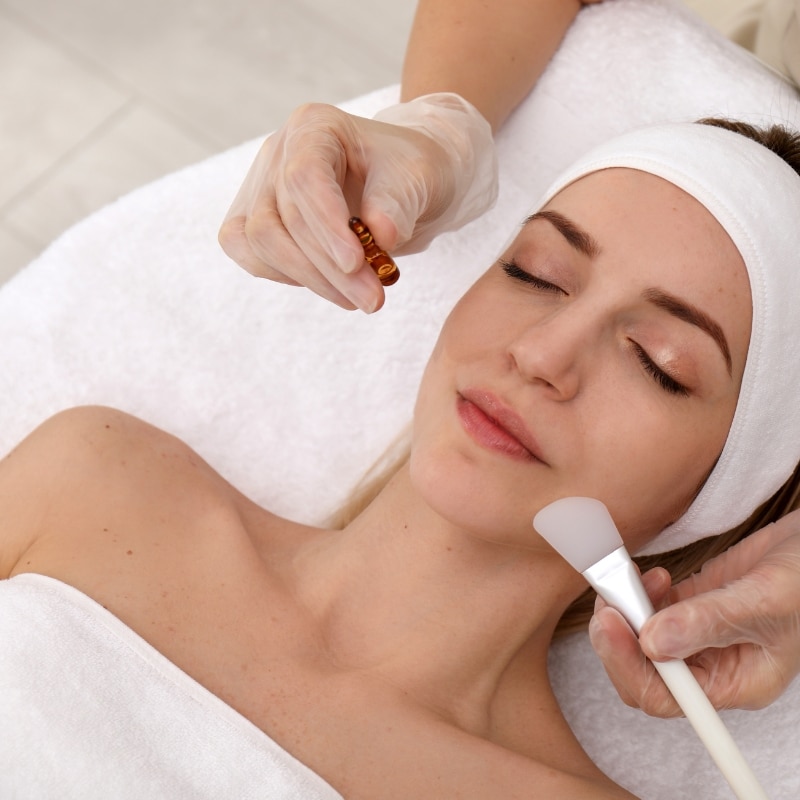Have you ever wondered how celebrities maintain their flawless skin? The secret might just be chemical peels, a top trend in skin rejuvenation today. This technique, known for its versatility, targets the top layers of skin to unveil a smoother, more radiant complexion beneath. Whether you’re battling fine lines, acne, or uneven skin tone, chemical peels offer a tailored solution to enhance your skin’s health and appearance.
From subtle refreshment to deep revitalization, chemical peels address a range of skin concerns. They are particularly effective for correcting sun damage, reducing scars, and evening out skin pigmentation. If you’re looking to restore that youthful glow or clear up persistent skin issues, understanding the ABCs of chemical peels can be your first step toward achieving clearer, more youthful skin.
Types of Chemical Peels
Chemical peels are categorized into three levels:
Light Peels
Light peels are ideal for those new to chemical peels or with minor skin concerns like fine lines, mild acne, or uneven skin tone. Light peels often use alpha-hydroxy acids like glycolic or lactic acid to gently exfoliate the outermost layer of the skin, promoting a healthy glow with minimal downtime.
These peels are sometimes referred to as “lunchtime peels” because you can typically return to your daily routine immediately after the procedure.
Medium Peels
These are stronger and target the outer and middle layers of skin, making them effective for treating age spots, deeper wrinkles, and moderate sun damage. Trichloroacetic acid (TCA) is commonly used for medium peels. The recovery time is longer, usually about a week, with more noticeable peeling and redness during the healing process.
Deep Peels
Offering the most dramatic results, deep peels penetrate into the lower dermal layer of the skin to correct more serious imperfections such as deep wrinkles, scars, or even precancerous growths. Phenol is often the active ingredient in deep peels. Due to the intensity of the peel, recovery can take several weeks and involves significant peeling, redness, and sensitivity to sunlight.
Each type of peel is suited to different skin concerns and desired outcomes. Light peels can be repeated at regular intervals to maintain results. In contrast, medium peels might be done a few times a year, and deep peels are generally only performed once due to their extensive nature.
Before the Procedure
Preparing for a chemical peel is as crucial as the treatment itself. It begins with a thorough consultation with your dermatologist, who will assess your skin type, discuss your skincare goals, and review your medical history. This step ensures the peel is tailored to your specific needs, minimizing risks and maximizing results.
You may be advised to stop using certain skincare products that could interfere with the peel’s effectiveness, such as those containing retinol or other exfoliants, a few weeks before the procedure. Additionally, protecting your skin from the sun and maintaining hydration are key preparatory steps that your dermatologist will emphasize.
In the weeks leading up to your peel, your dermatologist might also recommend using specific products to precondition your skin, making it more receptive to the treatment. This might include topical retinoids or bleaching agents to ensure even penetration and reduce potential complications like post-inflammatory hyperpigmentation. It’s also essential to disclose any history of cold sores or facial X-rays, as these can affect your treatment plan.
During the Procedure
The process of undergoing a chemical peel is meticulous to ensure safety and effectiveness. Your skin is first thoroughly cleaned to eliminate any impurities, such as dirt, oil, or makeup. For your safety, sensitive areas around your eyes and lips will be protected with a special gel or ointment to prevent any potential irritation from the peel solution.
As the chemical solution is applied to your skin, typically using a brush, cotton applicator, or sponge, you might experience various sensations depending on the depth of the peel. For a light peel, you may feel mild tingling or stinging, which is normal as the peel works to exfoliate the outer layer of your skin.
For deeper peels, like those using trichloroacetic acid (TCA), the sensation could intensify to a burning or throbbing feeling. Throughout the procedure, your practitioner may use cool compresses or provide a hand-held fan to help alleviate any discomfort.
The procedure is methodically timed, and once the designated time has elapsed, the peel is either washed off or allowed to neutralize naturally, depending on the type of peel.
After the Procedure
After undergoing a chemical peel, it’s essential to focus on gentle aftercare to ensure optimal healing and achieve the best results.
- Immediately following the procedure, you should apply a gentle, water-based moisturizer to keep your skin hydrated. This helps minimize irritation and redness.
- It’s also crucial to avoid any direct sun exposure, as your skin will be particularly sensitive. Wearing broad-spectrum sunscreen and protective clothing like wide-brimmed hats and sunglasses is recommended whenever you’re outdoors.
During the first few days after the peel, your skin may start to peel and flake. This is normal, and you should not pick at or peel off the flaking skin, as this can lead to scarring and uneven healing. Instead, continue to moisturize and cleanse your skin gently with cool water and a mild cleanser, using your fingertips instead of abrasive tools.
The intensity of peeling and the recovery time will depend on the depth of the peel. Light peels might require minimal downtime, whereas medium to deep peels might necessitate a more cautious approach to skin care for several weeks.
Potential Risks and Side Effects
Chemical peels, while effective for rejuvenating the skin, come with potential risks and side effects that vary based on the depth of the peel. Common side effects include:
- Redness
- Dryness
- Peeling of the skin
More severe effects can include:
- Swelling
- Scarring
- Changes in skin color
Particularly for deeper peels, there’s a risk of more significant swelling and even hyperpigmentation or hypopigmentation, which may be permanent.
Unlock Your Skin’s Potential
Chemical peels offer a transformative solution to rejuvenate your skin. They address issues from fine lines to uneven pigmentation, revealing a smoother and more youthful complexion. The key to maximizing these benefits while minimizing potential risks lies in professional guidance.
At Zeam Health & Wellness, our experts are dedicated to ensuring your safety and optimizing your results. We invite you to schedule a consultation with us, where we can tailor a treatment plan specifically for your skin’s needs. Let us help you unlock your skin’s potential and achieve the radiant, healthy skin you deserve.




